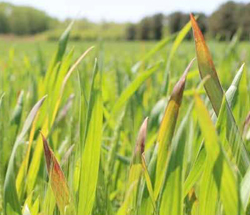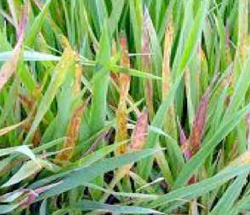CROP PROTECTION: Barley Yellow Dwarf Virus
 The yellow dwarf diseases of cereals have now been divided into two groups:
The yellow dwarf diseases of cereals have now been divided into two groups:
- Barley yellow dwarf virus (BYDV)
- Cereal yellow dwarf virus (CYDV)
They are the most important virus diseases of cereals worldwide. They have a wide host range which includes wheat, barley, oats and over 150 grass species.
The virus is usually spread by aphids from infected grasses to crops. Wet seasons promote growth of host grasses and build-up of aphid vectors resulting in early crop infection, severe symptoms and yield losses. Yellow dwarf viruses (YDV) tend to be more serious in the high rainfall cropping but can as well occur in all cropping regions. The virus is best controlled by monitoring and spraying for aphids early in the season.
What to look for
Symptoms of barley yellow dwarf are highly variable and can be confused with those of wheat streak mosaic, nutrient deficiency, root and crown diseases, and environmental stress. Barley yellow dwarf is tentatively diagnosed from the presence of aphid vectors and the occurrence of yellowed, stunted plants grouped singly or in small patches among normal plants.
Leaf discoloration in shades of yellow, red or purple from the tip down and from the margin to midrib is typical. In wheat symptoms start to become obvious at about the jointing stage of growth. Barley yellow dwarf does not produce a distinct mosaic pattern as do wheat streak mosaic or soil-borne mosaic. The pale yellowing of older leaf tips is typical. During cool temperatures the tips can sometimes become a reddish-purple. In years with high aphid activity the patches of BYDV-infected plants can become quite large in some fields.
 Symptoms take at least 3 weeks to appear after infection. The symptoms first appear where aphids have landed. Flying aphids may infect individuals or groups of plants dotted throughout the crop. If the aphids colonize the crop rings or patches develop which increase in size with time. If crawling aphids move into the crop from adjoining pastures or crops then symptoms will appear along the fence line first.
Symptoms take at least 3 weeks to appear after infection. The symptoms first appear where aphids have landed. Flying aphids may infect individuals or groups of plants dotted throughout the crop. If the aphids colonize the crop rings or patches develop which increase in size with time. If crawling aphids move into the crop from adjoining pastures or crops then symptoms will appear along the fence line first.
YDV symptoms can be variable and can differ with host species, cultivar and time of infection. Sometimes, infection of cereals may occur without visible symptoms. However, distinct symptoms usually occur on cereals although many infected grasses are symptomless.
Barley
Symptoms include yellowing of the leaves, starting at the tip of the leaf and moving towards the base, resulting in brilliant yellow coloration of the leaves and interveinal chlorosis.
Early severe infections can lead to:
- stunting
- abortion of florets
- delayed maturity
- Shriveled grain.
Late infections do not result in severe stunting but young leaves may turn yellow.
Wheat
Symptoms vary between cultivars and leaf yellowing may be slight to severe with interveinal chlorosis. Early severe infections can result in:
- increased number of poorly developed tillers
- reddening of flag leaves
- delayed maturity
- shriveled grain
- Reduced yields.
- Late infections may only cause slight yield loss and slightly shrivelled grain.
- Disease cycle
The YDVs have a very wide host range in the grass family (Poaceae). They survive between cropping seasons in volunteer cereals, annual and perennial pasture grasses and wild grasses. The virus and vectors can survive in small pockets of surviving grass even in the low rainfall areas. The aphid vectors of the viruses tend to build up in autumn and spring on the grasses, and then move into cereal crops where they often develop colonies. High rainfall areas have a greater buildup of the grasses, virus and vectors.
The viruses are not transmitted by any other insects and are not transmittable through seed, soil or sap. The aphids need to feed on an infected plant for at least 15 minutes followed by a latent period of 12 hours, before the virus will transmit to a healthy plant. Aphids remain infected for the rest of their life.
Management
Early sown crops or long season crops sown in high rainfall areas are particularly vulnerable to this disease. Where resistant varieties are not an option, the management of aphid activity in crops especially early in the season to prevent its spread and or delayed sowing to avoid the main aphid flights can reduce YDV infection.
Later sowing to avoid the main aphid flights will reduce the incidence of YDV but this needs to be weighed up against possible yield reduction from delayed sowing.
Genetic Resistance
An important strategy to manage BYDV is to plant resistant or tolerant cultivars. High levels of resistance or tolerance are not available in wheat; however, commercial cultivars vary in their susceptibility to barley yellow dwarf. A good strategy is to grow diverse varieties to minimize the potential that a single variety will be severely affected by the disease
Cultural Practices
Cultural methods of managing barley yellow dwarf include controlling grassy weeds, including volunteer cereals, within and near wheat production fields. These practices will minimize the virus and vector reservoirs in wheat growing areas.
Chemical/Biological Control
Fungicides have no effect on barley yellow dwarf and should not be applied to control the disease. Seed treatments of imidacloprid or thiamethoxam can reduce aphid populations through the fall and, therefore, reduce primary infections.
However, insecticide seed treatments to control aphids may not be economical because of the sporadic nature of aphid infestations. Foliar insecticide control of aphids in the fall can reduce the incidence of barley yellow infections, but may not be economical if aphids escape the treatments or migrate in from untreated areas.
Delayed sowing
Late sowing to avoid the main aphid flights will reduce the incidence of YDV but this needs to be weighed up against possible yield reduction from delayed sowing.